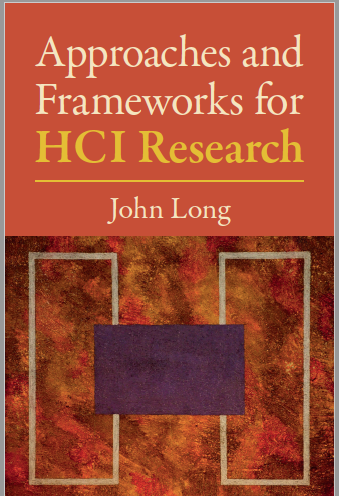
Introduction
The Approach Archive takes on its new function as archive of the website, rather than constituting the website itself. The change occurs at the same time as the book ‘Approaches and Frameworks for HCI Research’ is published. The author is John Long. The publisher is Cambridge University Press (CUP). The publication date is March, 2021 ( www.cambridge.org/9781108719070).
The Approach Archive, as a website, provided the basis for the book. The book now replaces the website. So, why retain the archive? Here are the reasons.
First, the archive provides access to original material, which is referenced and discussed by the book, but not included in it. An example is the research paper of Long and Dowell (1989), which is central to the book’s general framework.
Second, the archive makes a number of these original materials more accessible to the reader. An example, is the different length summaries of the Long and Dowell (1989) paper.
Third, readers may be interested in the development of the ideas by the website, which did, or did not, find their way into the book.
However, it must be made clear, that from the date of its publication, the book replaces the website. The latter exists only as an historical archive and cannot be referenced in any other way.
Approaches to HCI Research
Introduction
Approach
An approach is a way of dealing with a situation or problem. For example, traditional and modern approaches are both ways of dealing with the problem of how to educate young children.
An approach involves thinking about and doing something. For example, traditional and modern approaches to educating young children have thought about and carried out different types of rote learning and play learning respectively.
An approach’s thoughts and actions in dealing with a situation or problem constitute a way forward for that approach. For example, traditional and modern approaches to educating young children both set out the preliminary steps of such an education and the particular manner of taking such steps by both approaches respectively.
Finally, an approach has ways of establishing whether a situation or problem has been dealt with or not. For example, traditional and modern approaches to educating young children are able to try out and to compare rote learning and play learning to see which leads to their better education.
DerivationApproaches are here expressed in terms of everyday language. A number of representative information sources were selected both on-line, for example, Wikipedia and off-line, for example, Webster’s Dictionary. The definitions of ‘approach’ were compared and the main common features were identified, for example, ‘approach as a way of dealing with a situation or problem’.
Approach to HCI Research
An approach to HCI is a way of dealing with the problem of human-computer interaction. For example, both innovation and science are ways of dealing with the problem.
An approach to HCI involves thinking about and doing HCI. For example, innovation and science approaches to HCI have both thought about and carried out work on human-computer interaction. Innovation seeks to develop new types of interactions. Science seeks to understand those interactions.
An HCI approach’s thoughts and actions in dealing with the problem of human-computer interaction constitute a way forward for that approach. For example, innovation and science both set out the preliminary steps and the manner of taking those steps to develop new types of interaction and to understand those interactions respectively.
Finally, an approach to HCI has ways of establishing whether the problem of human-computer interaction has been dealt with or not. For example, innovation and science approaches are able to try out and to compare their respective effects on those interactions.
No approach to HCI research is excluded here.
DerivationApproaches to HCI research are here expressed in terms of everyday language. A number of representative information sources were selected both on-line, for example, Wikipedia and off-line, for example, Webster’s Dictionary. The definitions of ‘approach’ and ‘HCI research’ were each compared and the main common features for each were identified, for example, an approach to HCI research is a way of dealing with the problem of human-computer interaction.
Approaches to HCI Research
Approaches to HCI research were identified from the research literature. They were then generified against the HCI fields, both at the category and at the individual field level. Approaches to HCI research were retained, if they exhibited a distinctive relationship with HCI research fields at both levels.
DerivationA review of the HCI research literature identified a number of approaches to HCI research, for example, as Applied Science and as Innovation. These approaches were then compared to a comprehensive listing of HCI fields by category, for example, Academic Disciplines (such as Social Sciences); Interdisciplinary Overlapping Fields (such as Human Factors); and Design Practices (such as Graphic Design) [1].
The HCI research approaches were then generified against the HCI research fields, both at the category and at the individual level. For example, the Applied Science approach is closely related to the category of Academic Disciplines, including the specific discipline of Social Science. Likewise, the Innovation approach is closely related to the category of Design Practices, including the specific design practice of Graphic Design.
Approaches to HCI research were retained, if they exhibited a distinctive relationship with HCI research fields both at the category and the individual level. Other approaches can, of course, be added, using the same process and criteria, as those described here.
[1] Rodgers, Y. (2012) HCI Theory – Classical, Modern, and Contemporary (Morgan and Claypool)